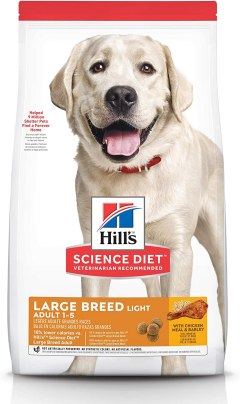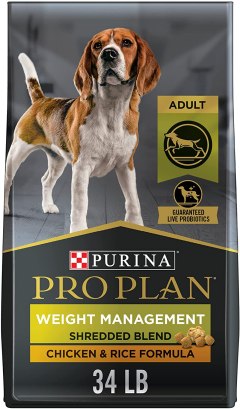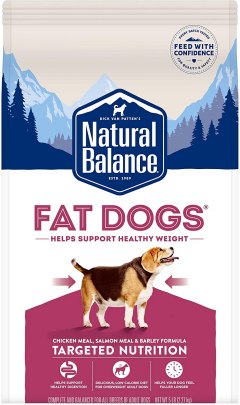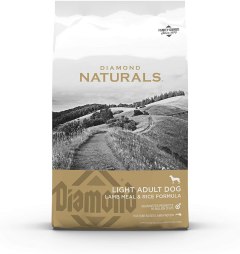BestReviews is reader-supported and may earn an affiliate commission. Details

This popular dog food is filled with nutrients, is low in calories, and is a great choice for overweight dogs.
Made with reduced-fat and reduced-calorie formula. Uses antioxidants and vitamins to improve immune health. Contains omega-6 fatty acids and vitamin E for healthier skin and shinier coats. Includes only natural ingredients in the formula.
Undergoing a slight change in formula, so your dog may not tolerate the new blend.

You get more for your money with this delicious weight management dog food.
Primary ingredient used is chicken. Contains shredded blend of chicken and rice. Made with guaranteed live probiotics to boost digestive and immune systems. Package contains 34 pounds of dog food.
Product contains corn, which dissatisfies some customers.

This dog food is made to support a healthy digestive system for your dogs and keep them fuller longer.
Package contains 5 pounds of dry food. Great source of wholesome grains, fiber, vitamin E, vitamin C, and zinc. Contains balanced omegas for healthier skin and shinier coat. Low in calories. Highly palatable for better satisfaction.
Some noted food may cause dogs to poop more frequently.

This highly digestible dog food is low in fat and is made to support a healthy immune system for your dog.
Tested and proven to soothe digestive tract. Contains prebiotic fiber to promote activity of beneficial gut bacteria. Reduces risk of urinary stone formation. Packed with protein fibers and gingers.
More pricey than other options.

This dog food is made specifically for overweight or less active dogs.
Contains glucosamine and chondroitin for good joint and cartilage health. Made with guaranteed probiotics for better digestive and immune health. Enriched with superfoods to provide more complete nutrition. Package contains 30 pounds of dry food.
Some noted unpleasant smell.

We recommend these products based on an intensive research process that's designed to cut through the noise and find the top products in this space. Guided by experts, we spend hours looking into the factors that matter, to bring you these selections.

A proper diet and stimulating activities are key for any dog to live a happy and healthy life. Low-fat dog food can help certain dogs with specific health issues to get them back on the right track.
Low-fat food is useful for any dogs who suffer from gastrointestinal issues, which can arise as a result of difficulty digesting fat. These formulas will contain 10% fat or less; most standard formulas include between 10% to 25% fat. Dogs who may be overweight or can lose a few pounds may benefit from some low-fat diets as well.
Finding the right formula to meet all the needs of your dog is an important decision that requires research and care. Dog owners need to be aware of their dog’s behavior and any potential issues, which are aided by regular visits to the vet.

Dogs who suffer from digestive issues, liver disease, or pancreatitis are often directed to low-fat diets by veterinarians. Excess fat and lack of fiber are some of the main contributors to digestive issues, and it’s not uncommon for dogs to struggle to digest fats. These formulas tend to be packed with probiotics, minerals, and other nutrients that are easily absorbed and ease any tension in the digestive tract. Low-fat dog foods can also help dogs lose weight in some cases.
However, It’s important to avoid associating fat in dog food with fat in human food. Owners may see fat as unhealthy for dogs due to perception about human food, but dogs are well-served by fat, and deficiency can result in health issues. Fat provides vitamins and minerals and contributes to healthy skin and coat if it comes from healthy animal sources.
Low-fat dog food generally falls into one of two categories: weight management or GI formulas. Weight management options are for those dogs who need to lose some weight and generally are high in protein and low in fat and calories. While formulas targeting gastrointestinal sensitivities are also low in fat, they also often avoid ingredients that are known to cause negative reactions and are hard to digest. These are also high in fiber. While weight management foods are merely focused on losing weight, GI options are focused on digestion.
Dog food comes in dry or wet form. Dry dog food, known as kibble, is more popular for its cost-effectiveness, easy storage, and general enjoyment by dogs. Kibble lacks an odor and also helps to clean teeth. However, some dogs with gum or teeth issues may require wet food, which is softer and gentler to chew. It’s also ideal for any dogs who aren’t getting enough daily water. Wet food is particularly odorous — while that may not appeal to humans, it does tend to entice picky dogs.
Dry low-fat dog food comes in a range of quantities. The smallest bags are around 5 pounds and best for smaller dogs or those owners who are trying out a new formula and aren’t sure about the results. Medium bags fall around 15 to 20 pounds, while larger options may reach 30 pounds or more.
While larger bags of low-fat dog food cost more, they tend to offer a better price per pound, provided your dog can go through the bag in a timely manner. Be sure you have room to store large bags as well as a sizable airtight container in order to preserve it.
Wet food often comes in a 6.5-ounce or 13-ounce can, with six or 12 cans to a pack.

Note the first five ingredients listed on the formula, as these constitute the majority of what makes up the food. Ingredients are listed in descending order with the most prevalent ingredient, almost always meat, included first.
There are a couple of keywords to keep an eye out for. “Meal” is commonly found in ingredients, as in “cornmeal” or “chicken meal.” This simply means the ingredient has been ground up and the water content has been removed, which helps keep the formula dense.
Also, note the word “byproduct.” This refers to parts of the animal that are secondary to the main portion, such as the feet, nose, tongue, and internal organs. Some claim that byproducts are nutritious and appetizing for dogs, while others contend that because byproducts are not safe for human consumption, they should not be included in dog food. In some cases, a highly regarded company may include byproducts that have been safely handled and processed, but in other cases, it can be a way for a less reputable brand to save costs and provide cheap formulas that may lack nutritional content.
It’s important that any low-fat dog food formulas still contain proper amounts of protein and carbohydrates. Watch out for formulas that achieve low-fat counts by using less meat, which in turn lowers the protein count. Similarly, carbs may increase in low-fat formulas. While they provide the fiber that aids in digestion, a high carb count may be problematic for older dogs or those with low energy who are trying to lose weight.
Some formulas may include probiotics and prebiotics to help the digestive tract and gut health. Probiotics are healthy gut bacteria made of microorganisms that aid a variety of systems, including the immune system, and may support weight management. Prebiotics are the fiber that healthy bacteria feed on. These supplements are often paired with a variety of other beneficial nutrients and minerals, including omega-3s.
Some low-fat formulas that target gastrointestinal issues are only available with a prescription from your veterinarian. This will likely come as a result of various tests to determine specific issues.
Dog bowl: Amazon Basics Stainless Steel Dog Bowl
Every dog owner needs at least one bowl for food when serving a meal. This choice by Amazon Basics is durable, easy to clean, and inexpensive.
Dog dental chews: Greenies Original Natural Dental Dog Treats
Maintaining healthy teeth and gums in your dog can help them avoid any number of serious illnesses. These popular chew treats by Greenies are effective at keeping teeth clean and improving bad breath.
Inexpensive: Smaller portions of low-fat dog food can be found for $20 or less. This is typically dry food or kibble.
Mid-range: Most low-fat dog food, including medium-size bags of dry kibble and packs of wet food, cost between $20 and $40.
Expensive: The largest bags of low-fat dog food cost over $40, including high-quality gastrointestinal formulas that may exceed $50 or $60.


A. Diarrhea and loose stools can indicate an issue with your dog’s digestive tract, which may be caused by their food and require switching to a low-fat diet. If your dog is displaying adverse reactions, such as excessive shedding, drooling, or scratching, there may be an ingredient in their food that’s disagreeing with them.
Determining what that ingredient is may take time. It’s best to start with bland food and perhaps switch to a diet that has limited ingredients. Consistent issues should be brought to your vet’s attention, and tests may need to be done to diagnose the problem.
If your dog is overweight, it’s typically easy to tell by looking at their profile and noting the shape of their belly. Owners can feel for fatty deposits and inspect their rib cage. If their ribs aren’t easy to feel with a bit of pressure, they may be overweight with excess fat coverage.
A. The rise in popularity of grain-free formulas over the last few years is due in part to the perception that grains are harmful to dogs. As many humans avoid wheat and gluten, there’s an association that dogs may also be adversely affected. However, to date, there is no conclusive evidence that grains are harmful to dogs, and many vets in fact advise against such formulas, particularly because there’s a growing link between grain-free formulas and heart disease. While it's not uncommon for dogs to have sensitivities or allergies to corn or gluten, many recipes featuring rice, buckwheat, and flax are healthy and effective.
A. Some formulas may cater to a specific size or age, which is the first way to narrow down a search. Others may cater to all ages and lifestyles. Either way, it’s important that the formula offers a “complete and balanced diet,” which is a specific designation established by the Association of American Feed Control Officials (AAFCO).
Your vet may recommend a specific brand of low-fat dog food depending on your dog’s issues. If not, seek out formulas made by trusted, reputable brands that list quality ingredients.
Get emails you’ll love.
Learn about the products you’re wondering if you should buy and get advice on using your latest purchases.
